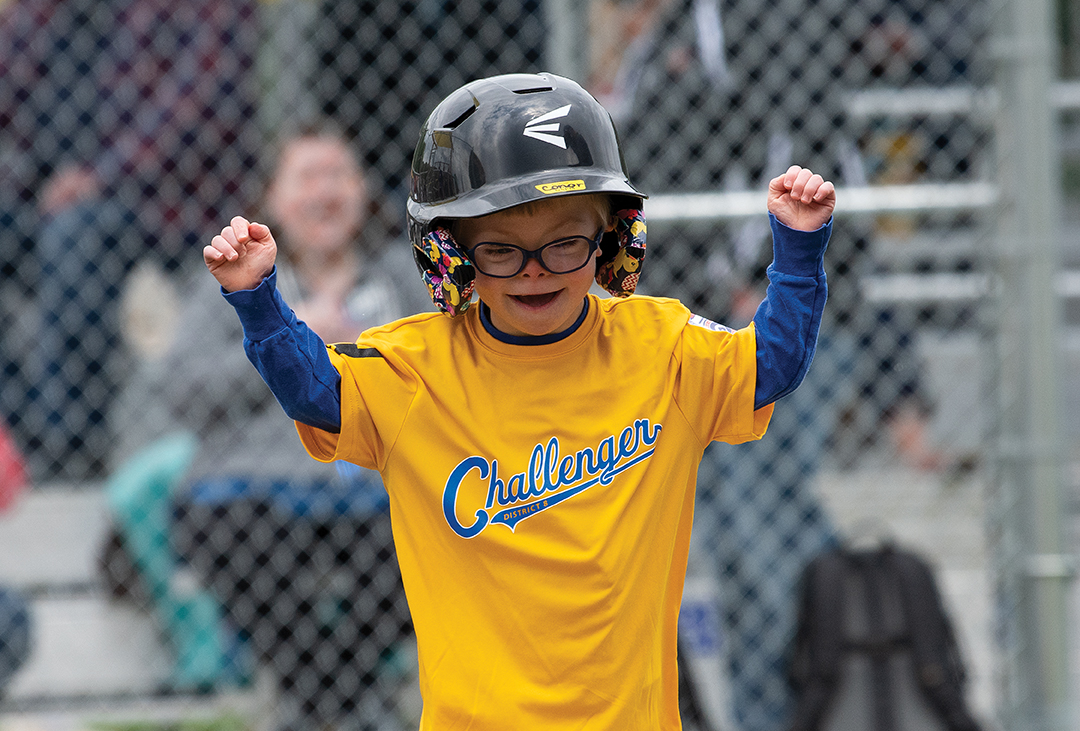
The Wicomico County Recreation, Parks & Tourism Department’s new Little League Challenger Program gives children with physical and intellectual challenges
the opportunity to play the great game of baseball
Conor Pellinger celebrates crossing home plate.
Written by Jonathan Westman
Photography by Grant L. Gursky
The opening day of baseball season is always one of the most anticipated times in sports.
It signals the dawn of spring, a renewed sense of optimism and the return of a game that offers so much joy and camaraderie for players, coaches and fans alike.
For the ballplayers of the inaugural Little League Challenger Program in Salisbury, a new league for young individuals with physical and intellectual challenges, taking the field for their first game was all the more special. This was their chance to experience the thrill of hearing their name announced over a loudspeaker, the rush of adrenaline that accompanies hitting a ball and racing around the bases and the emotions felt when a crowd cheers their accomplishments. Organized and conducted through the Wicomico County Recreation, Parks & Tourism Department, the Challenger Program is Little League’s adaptive baseball platform for players ages 4-18, or up to age 22 if still enrolled in school. Games are typically 1 or 2 innings in length, and everyone bats and plays defense every inning. Players are accompanied by “buddies,” who assist Challenger athletes in the areas of batting, base-running and defense, but only as needed. Often, buddies are peer athletes who are participating in the Little League Baseball or Softball programs, and on this day, members of Salisbury University’s club baseball team were on hand, serving as buddies to the players.
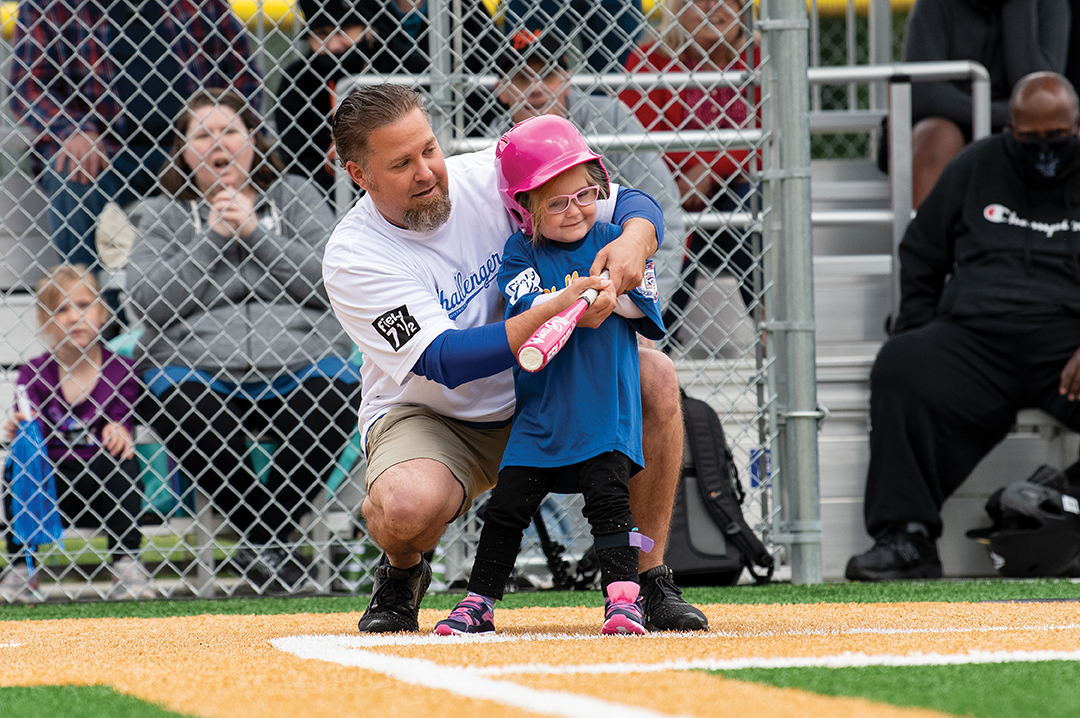
Kevin & Emerson Thomas
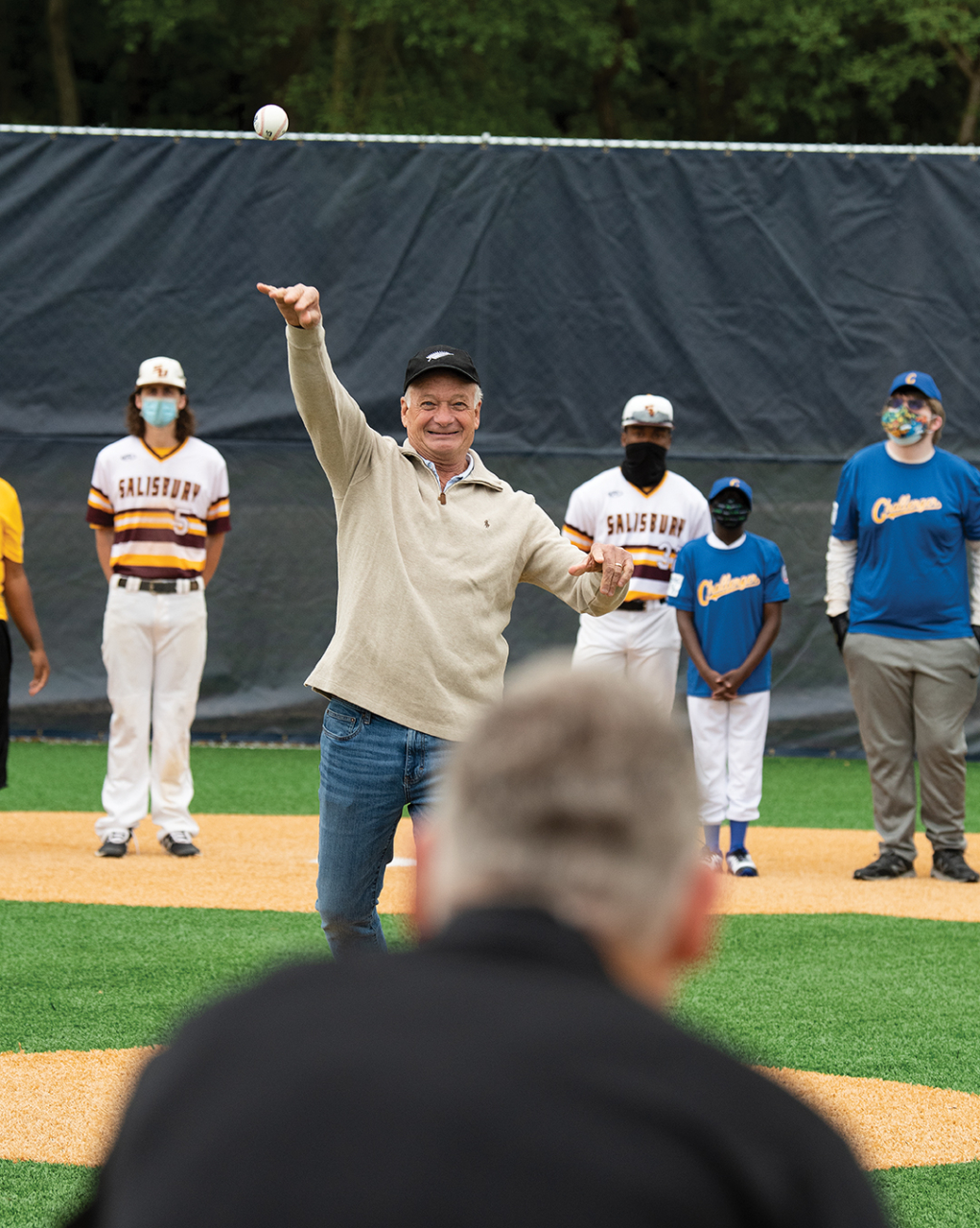
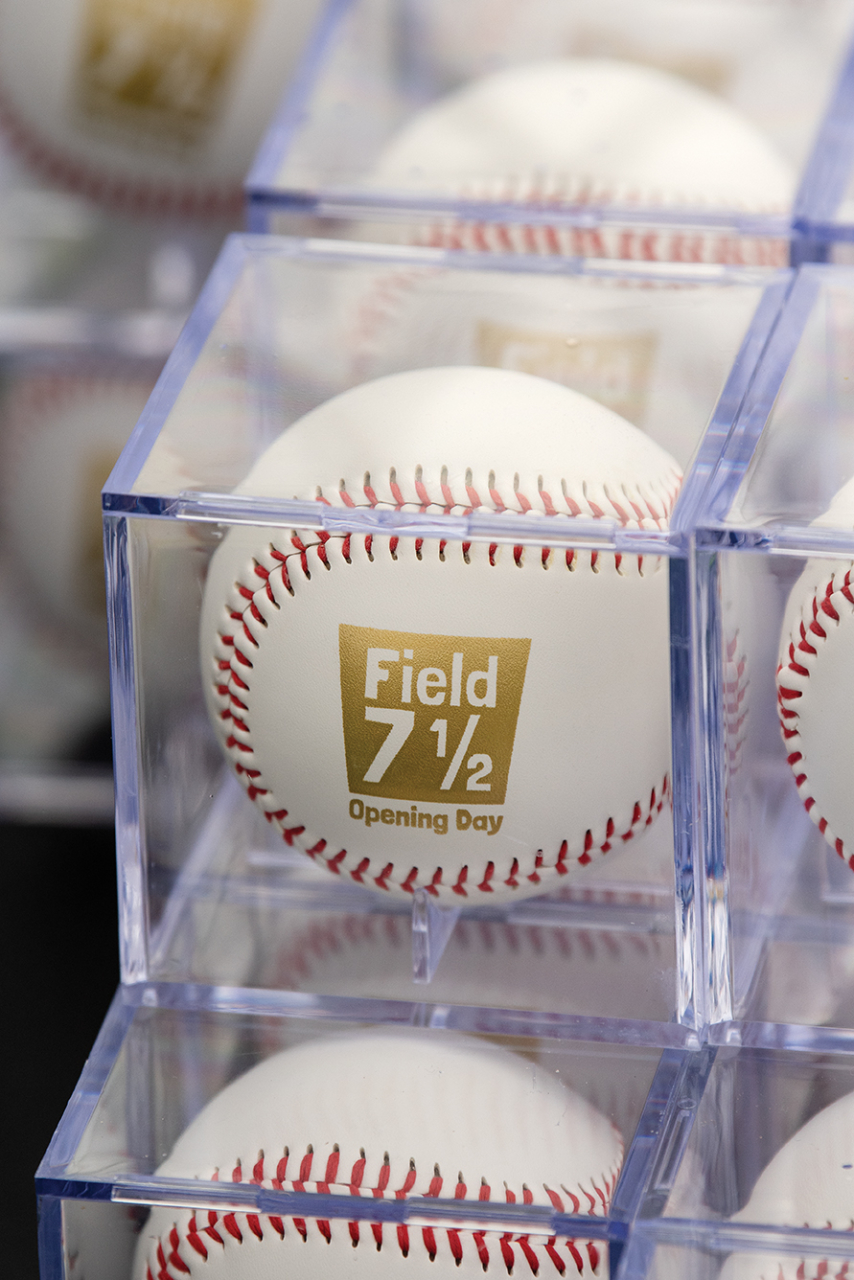
Jim Perdue throws the ceremonial first pitch.
“The number of smiles out here tells you what this is all about. My dad really loved baseball, and baseball has been very special to our family. We’re so excited to be part of this. This is a gorgeous field—a field that is going to allow kids to enjoy what this sport is all about.” — Jim Perdue
The Community
Chris Bitters knows baseball. The longtime general manager of the Delmarva Shorebirds has worked in the front offices of minor league organizations since 1999. He also knows the meaning of community, having served on the United Way of the Lower Eastern Shore board in addition to being named the 2012 Rotarian of the Year by the Wicomico Rotary Club for his civic contributions.
So, when he and Wicomico County Recreation, Parks & Tourism Director Steve Miller were brainstorming about potential new initiatives, Bitters proposed the Challenger Program, knowing that Maryland’s Eastern Shore didn’t have its own division. The pair formed an exploratory committee, and after speaking with parents, various community groups and the Wicomico Board of Education, concluded the program was needed locally.
“Things started running downhill from there,” Miller said.
A fundraising effort commenced and included state and county grants, contributions from the Perdue Foundation, the Donnie Williams Foundation, the Shorebirds Community Fund, local Rotary clubs, as well as private donations, among others, securing the necessary resources.
“It’s been tremendous. This has been a community-driven effort from day one,” Miller said.
“The Perdue Foundation was really the gas in the engine that we needed to really propel this forward, not just the amount of the donation, but the fact that they were behind it. It was a big deal to share that we had their support when we met with other potential donors. I don’t know that we’d be here without them.”
Perdue Farms Chairman Jim Perdue, whose father, Frank, played baseball while attending Maryland State Teachers College and later donated the land where the Shorebirds’ field, Arthur
W. Perdue Stadium, stands, threw out the ceremonial first pitch on Challenger’s opening day.

Jace Holloway
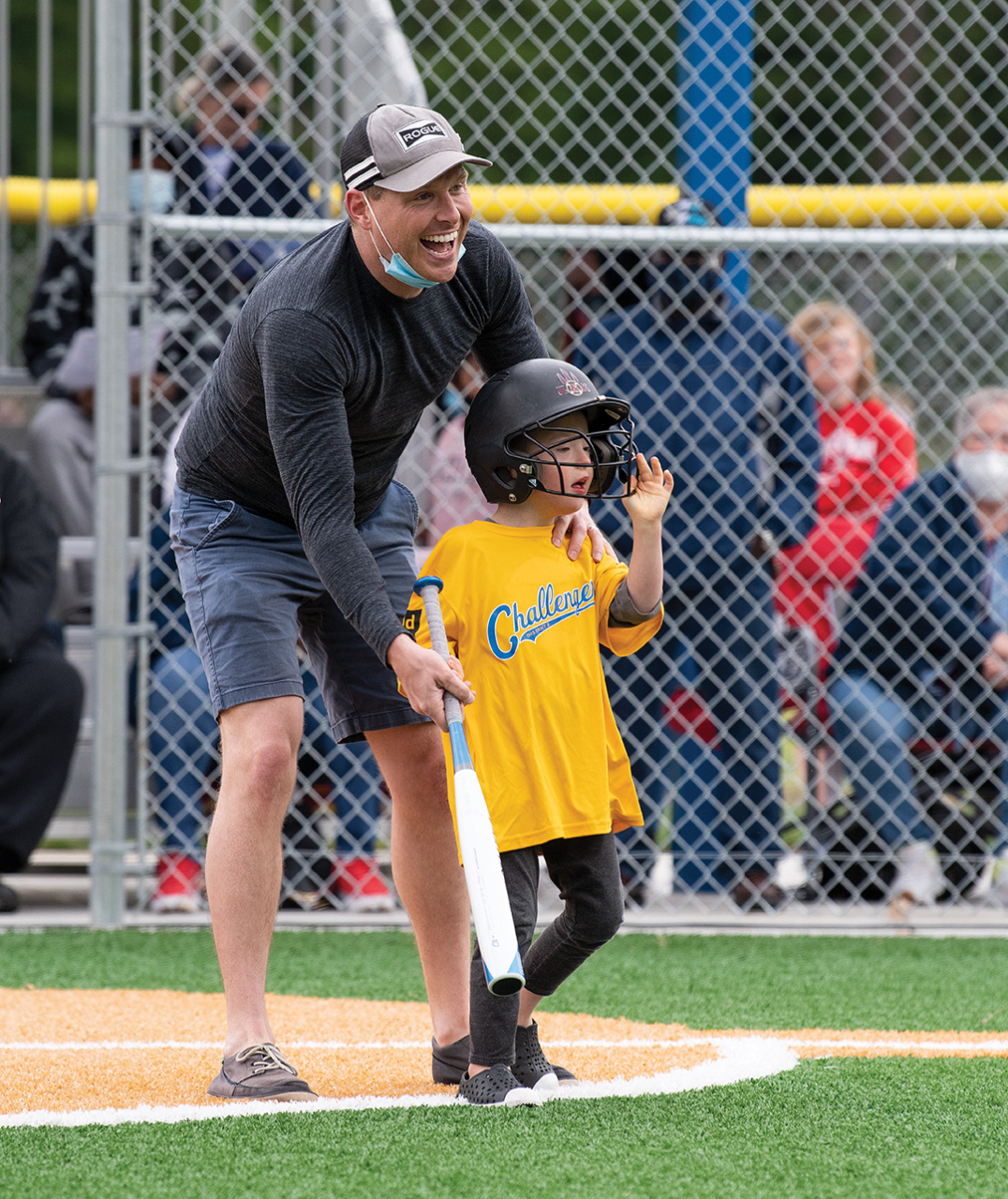
The project extends beyond baseball, through the creation of a nearby, all-inclusive playground, sponsored by the Donnie Williams Foundation, and a sensory trail behind the field that provides players and their families additional opportunities for interaction and connection.
“The playground is completely adaptive for kids who may be in a walker or wheelchair, and all of the equipment is accessible and designed for kids of all ability levels to play together,” Miller said. “During our planning discussions with parents, they shared that a sensory trail could be very beneficial. For example, if a child with autism needed some time in a quiet space because there was too much activity taking place around them on the field, the parent and the child could walk on the trail and find quiet time alone. There are three interactive activity pods on the trail now that offer children the opportunity to play in a more serene environment when necessary. We’re hoping to add a couple pods each year and introduce some new elements to the trail.”
Local Rotary clubs also built pavilions next to the field for families to dine together, complete with cutouts in the tables for wheelchairs and full changing stations in the event an accident were to occur while at the complex—providing a discreet and important amenity for parents and their children.

Steve Miller and Bryan LeCompte
The Field
With its debut, on April 6, 1992, Baltimore’s Camden Yards was celebrated throughout baseball for its retro features, modern amenities and salute to Orioles’ franchise greats in a courtyard setting with grand iron archways and brick walkways, lifelike bronze sculptures and handsomely engraved plaques that commemorate their achievements. Camden Yards ushered in a new era of retro-style ballparks, which, in part, has been used in the design and construction of 22 Major League Baseball parks since. It’s been said that when you’re at Camden Yards, you know you’re at the park where the Big Leaguers play.
Organizers for the new Challenger Program had plans for a special field at the Henry S. Parker Athletic Complex, too. Located between Fields 7 and 8, Field 7½ features soft, colorful synthetic turf, spacious dugouts and bleachers outfitted with shade structures. The Perdue logo occupies its rightful place on the turf along the first- and third-base lines, and banners of the field’s corporate supporters hang two-by-two along the outfield fence.
A majestic wrought-iron arch, adorned with the Field 7½ logo, welcomes players and their families to the field. The one-of-a-kind experience continues along a brick-paved, landscaped walkway that honors key contributors of the project with bronze plaques.
“I can’t speak enough of what Bryan did out here,” Miller said. “He took something that was going to be special and took it to another level. Now, when these kids come through the arch and pass the bronze plaques, it is just incredibly special for them.”
“This was a heartfelt team effort from everyone who gave their time and talents to transform a concept into a reality,” LeCompte said. “The greatest feeling in the world is to give, especially to those who can’t ever repay you. This project exemplifies the true spirit of giving—and the reward for everyone is simply to watch these kids play the game of baseball in an incredible setting. They deserve it.”

Cheyanne Shrieves and Steve Miller
The Players
Six-year-old Cheyanne Shrieves had been rehearsing for her big moment for weeks. The traditionally shy and reserved little girl from Delmar, MD, stood in her bedroom, make-believe microphone in hand, preparing to say the biggest two words of her life. Born with Down syndrome, Cheyanne practiced over and over, determined to not only shine on her big stage—but own it.
As county officials, distinguished dignitaries, leaders of local industries and her fellow players lined Field 7½, with TV cameras rolling and photographers capturing her every step and with a standing-room-only crowd in attendance, the time had come. Head held high, Cheyanne confidently walked from the third-base dugout onto the field, ready to officially commemorate the debut of the greater-Salisbury area’s Little League Challenger Program.
With her two tiny hands firmly wrapped around the microphone, Cheyanne proudly proclaimed, “Play ball!” to the roar of the crowd, which enthusiastically cheered her decree.
“She had it down pat, to the point where she almost had laryngitis,” said Cheyanne’s mother, Heather. “She was very excited for the opportunity and really enjoyed it.”

Tom & Conor Pellinger

Elle Thomas
The inaugural Challenger season opened with four teams of 10 players and provided them with much more than the opportunity to be on the field—it solidified for each a position of acceptance.
“Letting somebody be on a team is one thing, but it doesn’t guarantee inclusion,” said Heather. “That word really hits home with me—and it applies to this field, to this league and at the playground, too. Cheyanne has friends that use gait walkers and wheelchairs, and here, they can all play together and just be kids. Everyone is included. They’re actually playing and having a great time, and that’s a big thing.”
Through the Challenger initiative, the Shrieves family has made new and meaningful connections with families of Cheyanne’s teammates and players from other teams, creating a network of camaraderie and support that Heather said didn’t exist previously. While based in Salisbury, the Little League Challenger Program hosts players from Somerset, Dorchester and Worcester counties, and officials are hopeful that its availability reaches families across the Shore, to grow the league and its support system.
“We want this to be a hub facility where kids can come and play and build relationships,” Miller said. “We can envision really big things happening here for years to come.” CS
Email: Info@CoastalStyleMag.com
Phone: 410-205-MAGS
Terms of Use
